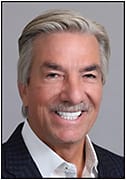Industry Insider is a timely chat with an ophthalmic industry thought leader.
Jim Mazzo has more than 40 years of experience in the ophthalmic industry. He was named CEO of Avellino in December 2020 after serving on the company’s board of directors, and he continues to be an active board member.
Avellino develops and manufactures AvaGen, a genetic test for keratoconus and corneal dystrophies — the first genetic test for the cornea — and plans to expand the line into glaucoma as well as other specialties including for dental and dermatology conditions. Avellino also manufactures the AvellinoCoV2 COVID-19 test, which surpassed 2 million performed tests in late June.
Mr. Mazzo has previously held CEO/senior leadership positions at companies including Zeiss, Allergan, AMO and AcuFocus. Before joining Avellino, he served as global president for Carl Zeiss Meditec’s strategic business ophthalmic devices unit.
In addition to serving as CEO of Avellino, Mr. Mazzo is the executive chairman of Neurotech, an advisor to Bain and Carl Zeiss Meditec, and is a board member with Visus Therapeutics, Preceyes, LensGen, Centricity Vision and Iantrek.
Ophthalmology Management: Can you give us an overview of the AvaGen test and how it works?
Jim Mazzo: What is unique about AvaGen is that it is the first genetic test that will allow eye-care professionals to really have what we call ‘personalized genetic data’ in order to quantify a patient’s risk of keratoconus and detect the presence of corneal dystrophies. This is my 44th year in the ophthalmic space, and this is the first genetic test the industry will have for the cornea, so this is really exciting.
Early identification is the critical component for any eye disease, especially progressive disorders like keratoconus. It’s underdiagnosed or misdiagnosed in many patients, so AvaGen can be a highly useful tool for ophthalmologists and optometrists to diagnose early and start early patient management.
As a genetic test, it also helps a doctor understand a family’s history with keratoconus, which can help proactively manage the condition; we can see if it emerged in a patient’s children or grandchildren. And this is not a complex task. The test is very simple — just a cheek swab that is sent to our lab in northern California.
We then send the eye-care practitioner a score card summarizing the findings, which they can in turn review with their patient. We also provide genetic counselors for the practice and patients who can help further explain the results. The medical professional can then manage the patient accordingly.
OM: How do you see genetic testing and gene therapy affecting the field of ophthalmology?
JM: From a big picture standpoint, if you look at health care today there are a lot of misdiagnoses. I have friends in other industries where the identification and misdiagnosis is so severe we end up wasting valuable time, energy and money. As we say at AvaGen, though, “the genes are talking,” and literally telling us what is going on in our bodies.
Genetic understanding is not new; it’s just new to the ophthalmic space. So, we are on a journey to build up large pools of data that will enable eye-care specialists not only to understand keratoconus, corneal dystrophies and other conditions, but to be able to target and personalize care to people with the related genes.
The foundation of gene therapy is accurate and can enable early and personalized diagnosis, and this is what we can bring to ophthalmology.
OM: What made you decide to join Avellino?
JM: After I retired from Zeiss I thought I would primarily join boards, such as my current executive chair role at Neurotech.
In this spirit, I joined the Avellino board in 2019 and, after one of our early board meetings in 2020, we were discussing the issues presented by COVID-19. Our founder, Gene Lee, said we could make a COVID test. That was very interesting to me and to the rest of the board. With this, we recommended and enacted a temporary pause manufacturing AvaGen and went full bore on developing a COVID test.
Around the same time we started making the COVID tests, we were discussing our plan to take Avellino public, first in South Korea in the first part of 2022 and then in the United States in the following years. We wanted someone in the CEO position who had business experience, and this is when I made the decision to fill this role.
We’ve added a lot of other talented people from across the ophthalmic industry since then as well. It’s been a rewarding and exciting journey.
OM: Have there been any operational challenges for Avellino during the pandemic?
JM: There were two main challenges. First, as nearly every business faced during COVID, we had to adapt to a virtual workspace. We were scaling up a company and hiring people using video calls and conducting very few in-person meetings. The ability to pivot the company in this way is something our team handled phenomenally, and during the pandemic we were still able to grow from less than 50 people to more than 200.
The other challenge comes when transforming from a science company to an operational company. It’s about taking great science and translating it into an efficient company that really understands the customer. It is about asking questions such as, “Are we hiring the right people? Where will the company be based? Can we buy enough materials to scale production?”
Ultimately, though, the problems we have are good ones. Whereas a lot of companies are coming out of quarantine trying to figure out how to be smaller, we’re figuring out how to grow and make a real impact on the future of health. OM









